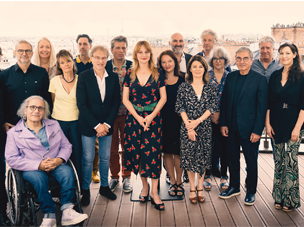A new tab has been added to sacem.fr: the Sacem Museum! Throwing open a window on the history of those who have kept creation alive for nearly two centuries: songwriters, composers and publishers... as well as their many thousands of works. A new heritage and educational website where you can browse, click to click...
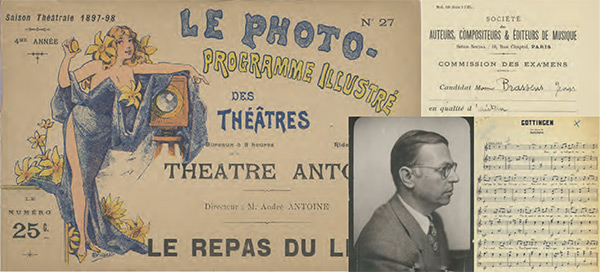
© Archives Sacem
Read a letter from Barbara to Jacques Higelin, find out about the story of Rue des Blancs Manteaux by Jean-Paul Sartre, examine George Brassens' entrance exam to Sacem... it's now available! Few people will be aware of this: Sacem has kept thousands of archival documents since its creation in 1851. Imagine then... nearly 30 linear kilometres of shelving filled with applications for membership, entrance examinations, correspondence, press clippings, contracts, declaration forms...
Memory in the limelight
"Over time, the Sacem archives, which were of an administrative nature, acquired a cultural value. The objective is not of course to transform the society of songwriters into a museum, but we must do justice to these archives... and through them, to all our members," explains Claire Giraudin, director of Sacem University and project coordinator.
The genesis of this online museum goes back several years and stems from a desire of creators and publishers to enhance the cultural heritage of Sacem. Their wish was formalised in 2013 with the creation of the Mémoire et patrimoine commission, at the instigation of Arlette Tabart, Jean-Pierre Bourtayre and Claude Lemesle, chaired nowadays by Nelly Querol, which brings together several members of SACEM "Faced with the accumulated richness over decades, we said to ourselves that we had to give greater prominence to this heritage... in short, to revive the past in order to think about the future," she explains. For five years, the commission has focused its work on setting up exhibitions, portraits, tributes..." In the background, we have thought for a long time about the project of an online museum, and it is a wonderful outcome to see it emerge today," enthuses Nelly Querol.
Several months of work
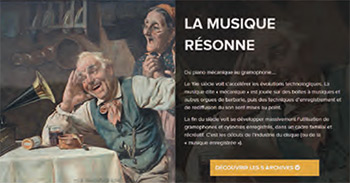
The "site under construction" entered a more concrete phase last spring. Over several months, the Sacem team, reinforced for the purpose, has been digitising thousands of documents. And partnerships have been forged with the Bibliothèque nationale de France, the Radio France discotheque, the Philharmonie de Paris, the Chambre syndicale de l'édition musicale (CSDEM) and the Chambre syndicale des éditeurs de musique de France (CEMF).
So what will you find in this museum? "The key word is diversity: diversity of creators, publishers, repertoires, regions, music, artistic practices," says Claire Giraudin. Of course, the most illustrious songwriters of the last 100 years will be duly represented. "Otherwise it would be very disappointing for Internet users," says the project coordinator. “But we will also present some less common things." For example? The promotion of operetta, dance music and overseas songwriters.
Editorial direction
When it opens, the Sacem Museum will present a selection of over 3,000 archival items... and this is only the beginning! As far as form is concerned, writing will be the main medium: membership applications and applications, entrance exams, letters, newspaper articles, photographs, declarations of works, scores and singles, programmes, magazines... All this, accompanied by documentaries about behind the scenes of creation, podcast interviews, or even playlists on legitimate audio or video streaming platforms.
Nor is there any question of abandoning the Internet user alone to face the myriad documents digitised by Sacem. An archive will be featured every day, and the editorial teams will select every week a " gem ": an original and particularly remarkable archive. Series will also be offered, like "the unexpected" which recounts the story of unsuccessful works that later became hits! And around ten exhibitions will be organised annually, such as May 68 or women in music creation.
Heritage for everyone
"In an archive that may seem administrative, a whole history of popular music comes to light, and it's something quite unique, " says Claire Giraudin. The documents also testify to the arrival of new audio tools over the years: the phonogram, then radio, television... we see that technology is changing and author's rights remain! In the end, it's reassuring in the face of the upheavals we're experiencing with the digital revolution and it puts things into perspective."
This is enough to satisfy the public's growing appetite for everything to do with heritage "The public is generally enthusiastic about preserving who we are and what represents us, and Sacem is part of this global movement," says Nelly Querol. And to summarise: " all the richness of the society is made available, in what will be a very concrete project for the public, offering a much greater visibility to our actions."
It is now up to the public to take advantage of this tool. "We will have succeeded in our mission if we have feedback from people outside Sacem, passionate people who will come to us with questions or proposals that will contribute to enrich the museum," says Nelly Querol.
My best-of... Claire Giraudin, Director of Sacem University
"I consulted all the archives that will be online for the Sacem Museum, especially for rights issues. Some of them moved me, such as Paul Verlaine's application for admission, which states that he is a "man of letters". Also this letter comes to mind from Boris Vian in 1958 to the then president of Sacem, referring to his status as an "intern" and asking him how to make progress. In my opinion, entrance exams can also have a surprising or solemn side: examples are those of Barbara, Georges Brassens, Edith Piaf... it's really something that stands out in a career, even for iconoclastic artists. And we can see that Sacem is their home. »
My best-of... Nelly Querol
"In this first selection available online, there are many documents that have touched me... and there will be more in the future! For example, a handwritten text of Barbara to Jacques Higelin, dating from 1988, which moved me a lot: it is a cry of respect and love that has been previously unpublished. I also think of Georges Brassens' entrance examination, the Boléro declaration paper signed by Maurice Ravel himself, or Louis Aragon's application for membership of Sacem in 1944. The museum really promises to be a superb tool. »
My Sacem exams... Claude Lemesle
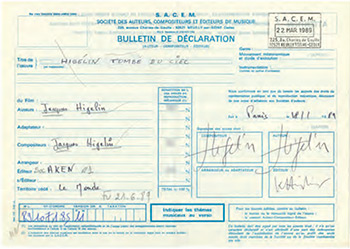
© Archives Sacem
"I passed it in March or April 1967. At 21, I was part of the Petit Conservatoire and I had already had a few songs recorded, so it was more of a formality. The proposed theme was "You close your door too fast", which was a little "down to earth", a song of banal break up. So I tried to put a little magic into it with lines like "Sleeping Beauty awake", and I got in!”
My Sacem exams... Vline Buggy
"I was soon to be 16, and my father, Geo Koger, was a prominent member of Sacem. Once I was locked in that famous room on the first floor of Chaptal Street with my envelope, I came across the following subject: "Where father passed"! First I wrote some very lyrical lines and, when the examiner came, I asked for another 15 minutes to write something else! And then, in just a few minutes, I imagined some rather funny lines about my father, which went something like this: "Where father passed his songwriter's exam / the daughter would one day want to match him..." and ended with .: "At the till where the father often goes/ One day his daughter would like to overtake him!". And that very evening, my father was overjoyed when he learned that I had received "with honours"!”.
2 questions to... Valérie Cottet, Sacem Director of Archives and General Resources
What can you find in the Sacem archives?
All the works submitted since 1851! But also the entrance examinations of our members, their correspondence, scores, concert hall programmes... In total, there are nearly 30 linear km of archives The particularity of our archives is that they are alive: we always use them within the framework of our relationship with the rights holders. We thus preserve ad vitam aeternam all the archives relating to authors, composers, publishers and works.
You recently developed the archive loan?
For four years, Sacem has been pursuing a policy of enhancing the value of its heritage. We are partners in exhibitions and festivals and lend our archives, most often by reproducing them in facsimile. Sometimes, they are originals as for the exhibition dedicated to Barbara at the Philharmonie or Edith Piaf two years ago, at the Bibliothèque nationale of France. We are being increasingly called upon for the works. Our archives are today at the heart of beautiful books, about Marcel Mouloudji, Serge Gainsbourg...
SARAH BENLOLO
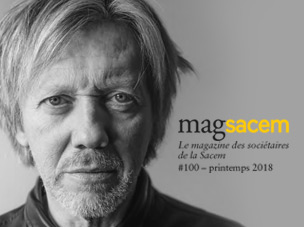
See other articles from Mag SACEM
Published June 19 2018

